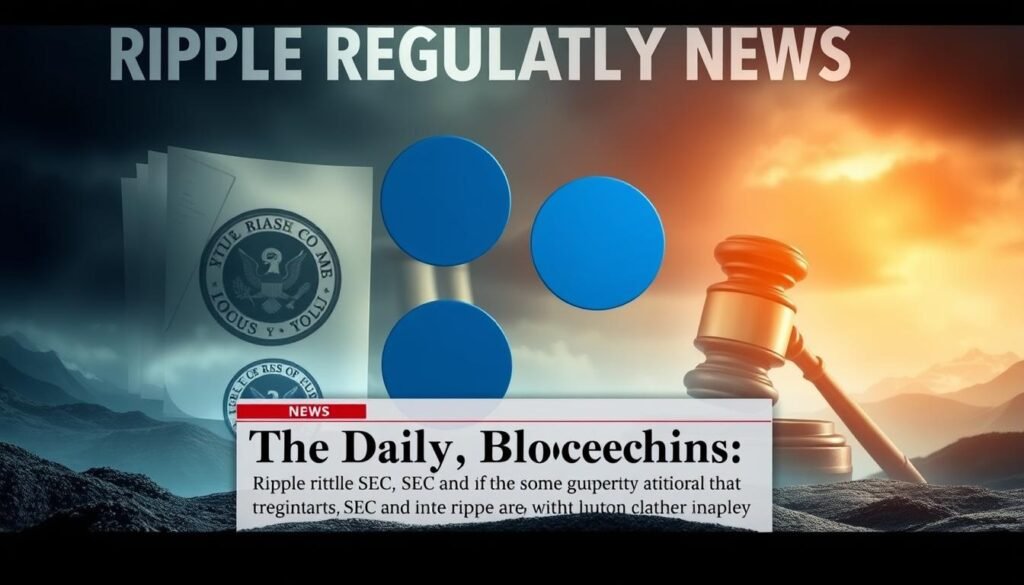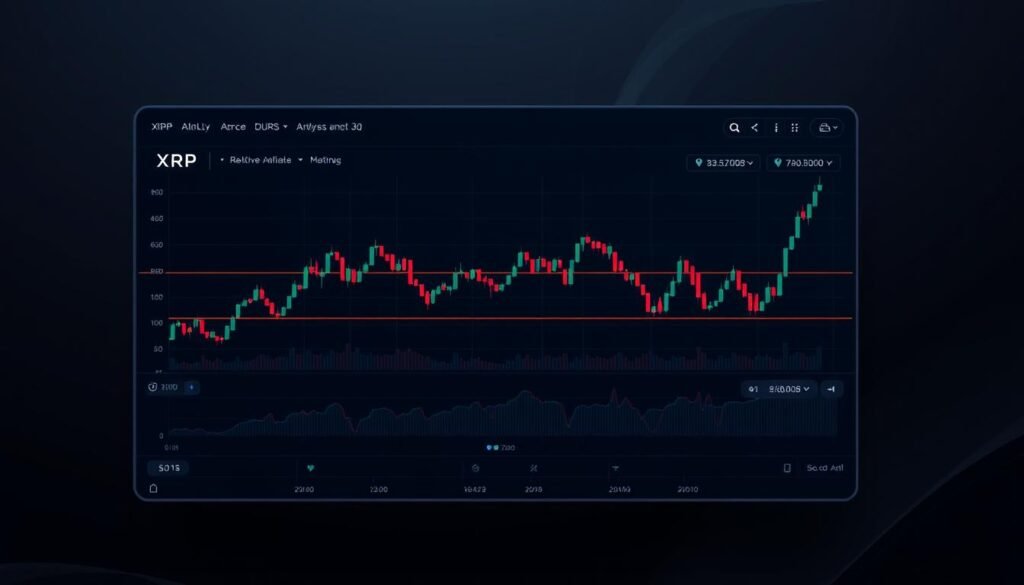Surprising fact: the asset commands a market capitalization of 165.58 B USD even while trading at just 2.76090 USD per coin.
Today’s snapshot shows a modest dip of −0.44% over 24 hours and a 24‑hour trading volume of 3.74 B USD. This piece ties price and policy to real outcomes for U.S. traders and institutions.
The long-running regulatory saga reached a clear moment on Aug 7, 2025, when appeals ended and exchanges were confirmed to trade the token without it being classified as a security. Founded in 2012, the network remains focused on payments for businesses and banks.
We frame the coverage with market data, practical implications, and concise technical context. Expect clear, neutral analysis on what the numbers mean for access, liquidity, and real-world payment use cases.
Key Takeaways
- Current price: 2.76090 USD, down −0.44% in 24 hours.
- Market cap sits at 165.58 B USD with strong institutional interest.
- Trading volume of 3.74 B USD keeps liquidity robust for many markets.
- Regulatory clarity on Aug 7, 2025, improved market access for exchanges and traders.
- Founded in 2012, the project remains focused on cross‑border payments for institutions.
Breaking News Overview: What’s Moving XRP Right Now
With the appeals process closed on Aug 7, 2025, exchanges and institutions now operate under clearer rules. That legal certainty has changed the trading backdrop and refocused attention on flows, volume, and macro drivers. Markets are parsing whether clarity leads to sustained buying or simply reopens trading ranges.
Key facts at a glance
- Regulatory status: Appeals ended Aug 7, 2025, confirming tradability on public venues.
- Current price: 2.76090 USD (−0.44% 24h).
- Near-term risk: Headline-driven bearish sentiment could test ~2.50 USD.
- Volume note: Upticks during declines signal active liquidity shifts, not quiet exits.
Why today’s developments matter for U.S. crypto markets
U.S. investors now weigh this legal clarity against broader market forces. Institutional comfort and exchange relistings can boost depth and lower trading friction.
Analysts remain split: some warn of short-term caution tied to seasonal weakness and BTC leadership, others point to a medium-term recovery path if capital returns.
“Legal certainty often precedes improved on-ramps and clearer compliance workflows, which help price discovery.”
| Item | Detail | Implication |
|---|---|---|
| Appeals | Closed Aug 7, 2025 | Removes major regulatory overhang |
| Price | 2.76090 USD | Short-term volatility, watch 2.50 USD |
| Market Signal | Volume rising on pullbacks | Liquidity rebalancing |
xrp latest update
Price action reflects a tug-of-war between daily risk-offs and longer-term buyer conviction. The token trades at 2.76090 USD, down −0.44% on the day. Weekly and monthly frames show mixed momentum: −8.65% week, −6.61% month, and a strong +387.70% over one year.
Key signals to watch center on chart structure, transaction flows, and venue liquidity. Technical ratings show a daily sell bias but a weekly and monthly buy tilt. That split creates intraday swings while keeping a recovery path visible on higher time frames.
- Short-term move: sellers pressure near-term levels; watch ~2.50 USD support.
- Medium-term context: ATH at 3.66596 USD (Jul 18, 2025) sets clear resistance.
- Market drivers: regulatory clarity, institutional flows, and transaction activity.
“Liquidity and transaction volume often explain sudden chart moves more than headlines.”
| Metric | Value | Why it matters |
|---|---|---|
| Price | 2.76090 USD | Current trading reference for intraday moves |
| Performance | −0.44% day, −8.65% week | Shows short-term caution vs longer-term gains |
| Technical ratings | Daily: Sell; Weekly/Monthly: Buy | Signals divergence across time frames |
Market Snapshot: XRP price, market cap, and volume at present
A quick look at price, market cap, and trading volume highlights short-term pressure and longer-term strength. This snapshot helps U.S. traders gauge liquidity and risk around current levels.
Live price action: XRP at around 2.76 USD
Live price: the token trades near 2.76 USD, down −0.44% over 24 hours. Intraday moves sit against a deeper one-week pullback and a strong one-year advance.
Market cap and 24h volume
Market cap is near 165.58 B USD while 24-hour trading volume runs about 3.74 B USD. The volume/cap ratio of ~0.0346 points to moderate turnover versus size.
Performance check: day, week, month, and one-year movements
- Day: −0.44% — intraday softness on lighter flows.
- Week: −8.65% — short-term pullback visible on the chart.
- Month: −6.61% — similar tone across a 30-day window.
- One year: +387.70% — clear annual strength despite recent movements.
| Metric | Value | Note |
|---|---|---|
| Price | 2.76090 USD | Daily sell bias, weekly/monthly buy |
| Market cap | 165.58 B USD | Institutional depth |
| 24h Volume | 3.74 B USD | Moderate trading activity |
| Volume/Cap | 0.0346 | Turnover vs. capitalization |
“Read day-to-day movements alongside cycle indicators and headline risk to understand flow changes.”
Legal and Regulatory: Ripple-SEC case closure and its impact
With appeals withdrawn on Aug 7, 2025, exchanges and institutions gained clearer footing to revisit listings and product plans. This resolution closes a multi-year legal chapter that shaped access for U.S. traders and custodians.

Appeals withdrawn; XRP not a security on public exchanges
The withdrawal confirms the asset is not a security on public exchanges. That legal clarity removes a major overhang and sets a precedent in the broader crypto market.
What follows matters for operational and market structure.
- Exchanges can reassess listings and liquidity programs, improving access and spreads.
- Institutions may revisit custody, compliance, and product development with lower legal friction.
- Analysts see structural upside: tighter spreads and more efficient price discovery over time.
“Policy certainty reduces headline risk and helps free capital previously held back by legal questions.”
| Factor | Consequence | Why it matters |
|---|---|---|
| Appeals withdrawn (Aug 7, 2025) | Regulatory overhang removed | Clears pathway for U.S. market participation |
| Exchange operations | Relistings and product reviews | Improves liquidity and fiat on‑ramps |
| Institutional response | Increased custody and trading interest | Supports deeper market structure and USD flows |
Institutional Moves: Fresh capital and strategic bets
Gumi’s strategic token buy points to institutional appetite for compliant cross‑border rails. The Tokyo game developer invested 17 M USD to acquire 6,008,857 tokens aimed at improving payments and expanding blockchain operations.
Gumi’s $17M acquisition and cross‑border ambitions
The purchase signals that businesses are experimenting with on‑chain corridors for remittances and treasury flows. Compliance clarity on public venues makes tokens more viable for corporate use.
Positioning into easing cycles and compliance‑focused use cases
Institutions often time entries around macro shifts; an easing cycle can raise risk appetite and lower funding costs. That helps operations scale pilot projects into production corridors.
“Repeated institutional participation tends to deepen liquidity and boost partner confidence.”
| Item | Detail | Impact |
|---|---|---|
| Buyer | Gumi (Tokyo) | Corporate credibility for crypto payments |
| Allocation | 6,008,857 tokens / 17 M USD | Testing treasury and remittance use cases |
| Market effect | Moderate single‑deal price influence | Stronger if repeated by institutions |
Technical Picture: Levels, indicators, and volatility signals
Today’s chart action highlights key pivot zones that traders watch for signs of a sustained directional move.

Key risk and resistance zones
Watch the 2.50 USD level as the critical downside level. A break below this level would signal stronger selling and could accelerate the next move lower.
On the upside, resistance clusters near the all‑time high around 3.67 USD. That zone has capped rallies before and can thin liquidity on further advances.
Mixed timeframe readings
Technical ratings read as a daily sell, while weekly and monthly frames remain buy. This split creates intraday whipsaws but a constructive medium-term backdrop.
Volatility and risk management
Estimated volatility is about 5.10%. That level makes position sizing and stops vital, especially for leveraged traders.
“Confirm breakouts, respect stops, and watch order‑book behavior around pivotal zones.”
- Monitor reclaim of prior support-turned-resistance to validate a bullish shift.
- Set clear invalidation points if price breaks below near-term floors.
- Use tightened risk controls when volatility spikes to limit losses.
| Item | Value | Implication |
|---|---|---|
| Downside level | 2.50 USD | Key support; break increases downside risk |
| Resistance | ~3.67 USD (ATH) | Supply zone; watch liquidity |
| Volatility | 5.10% | Higher dispersion; tighten sizing |
| Timeframes | Daily: Sell; Weekly/Monthly: Buy | Short-term risk, longer-term constructive |
Supply Dynamics: Circulating, total, and cap considerations
The size of the float shapes how quickly orders move price and how deep liquidity runs on exchanges.
Circulating vs. total and hard cap
The circulating supply sits near 59.48B while total supply is about 99.99B. A hard cap at 100B reduces long‑term dilution risk and helps frame fair‑value models.
How supply affects market structure
With a market cap of roughly 165.58 B USD, float size influences spreads and execution costs for large orders. High-cap coins with sizable circulating supply tend to support smoother institutional execution.
- The volume/market cap ratio (~0.0346) is a simple gauge of daily turnover versus size.
- Distribution, token unlock schedules, and treasury practices can change liquidity over time.
- Supply dynamics alter narratives — less scarcity often shifts focus from staking to utility and payments.
“Order-book depth and float matter more than headlines when assessing likely slippage on big trades.”
| Metric | Value | Implication |
|---|---|---|
| Circulating supply | 59.48B | Defines tradable float and near-term liquidity |
| Total / Max supply | 99.99B / 100.00B | Caps long-term dilution; predictable issuance |
| Volume / Market Cap | 0.0346 | Turnover indicator; lower = less daily liquidity |
XRPL Fundamentals: Payments, efficiency, and network positioning
The XRPL is designed to move value with low latency and predictable cost, making it a natural fit for enterprise payment corridors. Its architecture prioritizes throughput and interoperability to reduce friction for businesses adopting crypto-enabled rails.
Cross-border payments, low-cost transactions, and enterprise focus
Fast, low-cost transactions are core advantages. The xrp ledger underpins rails that settle quickly and keep fees minimal for cross-border payment flows.
Ripple’s 2012 founder-era design targets predictable settlement and operational efficiency. That focus helps operations and treasury teams test tokens inside payment corridors and liquidity provisioning.
Eco-friendly profile and security posture in crypto payments
Energy efficiency and reliability matter for corporate adoption. The ledger’s consensus approach uses far less energy than proof-of-work blockchains while preserving strong security guarantees.
“Security and uptime are vital for users who run payment-critical workflows.”
| Feature | Why it matters | Example use |
|---|---|---|
| xrp ledger | High throughput, low fees | Cross-border payment corridors |
| transactions | Fast finality | Treasury settlement and micropayments |
| security | Stable validation for operations | Enterprise payment rails |
| eco-friendly | Lower energy profile than PoW | Aligns with corporate sustainability goals |
Price will reflect market sentiment, but network utility, payment volume, and enterprise adoption often shape long-run value. For U.S. businesses, the XRPL offers a practical balance of speed, cost, and security for real-world payments.
Exchanges and Liquidity: Where XRP trades and market depth
Where coins trade matters: venue depth often dictates execution quality in volatile sessions.
U.S. users can access the token on major exchanges such as Binance, Coinbase, and Kraken. Traders also connect brokers through TradingView for chart‑based trading and order routing.
Major venues and user access
Spot markets on these exchanges provide visible order books and tighter spreads for most retail trades. Custody options and fee schedules differ, so choose venues that match your needs for security and cost.
Spot vs. derivatives and market structure
Derivatives venues often show larger notional liquidity but can amplify price moves during BTC-led rotations. Spot depth tends to govern real settlement and transaction costs.
Daily volume is about 3.74 B USD with a volume/market cap near 0.0346. That ratio shows meaningful liquidity, yet flows remain sensitive to broad crypto sentiment.
“Top venue list and order-book depth matter most when institutions trade large blocks.”
| Venue type | Where to trade | Why it matters |
|---|---|---|
| Spot | Binance, Coinbase, Kraken | Tighter spreads, visible execution, custody options |
| Chart-driven | TradingView (broker connect) | Convenient routing, integrated analytics |
| Derivatives | Major futures venues | Higher funding, larger notional liquidity, can drive price swings |
Analyst Sentiment: Recovery setups vs. bearish overhang
Analysts describe a market split: short-term pressure and conditional signs for a rebound. Daily technicals read as a sell, while weekly frames hold a buy tilt. That creates a narrow window for risk‑taking and calls for close monitoring of order flow and liquidity dynamics.
Bearish September narrative and retail demand softness
Headlines point to a bearish September theme with retail demand weakening. That increases the chance price tests key floors and could reach 2.50 USD if flows stay light.
Volatility can spike on thin liquidity, so traders should size positions and set clear stop levels.
Recovery scenarios: what would signal a sustained big move
A sustained big move higher would likely require reclaiming nearby resistance levels and confirming momentum on the week time frame.
Watch for higher lows, expanding volume on up days, breadth improvement across crypto markets, and constructive action in BTC before broader risk appetite returns.
“Confirming higher lows and volume expansion on rallies is the clearest path to a real reversal.”
| Signal | Why it matters | Trigger |
|---|---|---|
| Higher lows | Shows buyer commitment | Series of weekly closes above prior lows |
| Volume on up days | Validates moves | Significant volume expansion vs. average |
| BTC leadership | Market correlation | Positive BTC trend often precedes recovery |
Conclusion
Market structure, supply limits, and confirmed compliance now form the core case for holders. The xrp price sits near 2.76090 USD with a market cap around 165.58 B USD and estimated volatility of ~5.10%.
The xrp ledger’s focus on fast, low‑cost payments remains a key practical advantage for businesses and tokens used in real transactions. Circulating supply near 59.48B against a 100B cap frames long‑term models.
Watchlist: liquidity at major venues, macro shifts, chart structure, and volume confirmation for the next decisive move. Cryptocurrency investing is volatile—match position size to risk tolerance and review assumptions as new data arrives.
Bottom line, foundational elements from supply to legal status now offer clearer conditions to evaluate this coin among cryptocurrencies.
FAQ
What is the current price and market cap of XRP?
The token is trading near .76 USD with a market capitalization close to 5 billion. These figures shift with market activity, so check real-time price feeds on major exchanges like Binance, Coinbase, or Kraken for the latest values.
How has XRP performed recently across key timeframes?
Performance varies by timeframe: intraday volatility is visible, weekly and monthly trends show mixed momentum, and one-year movement reflects broader crypto market cycles. Traders often review day, week, month, and year charts to spot momentum and risk levels.
What was the legal outcome in the Ripple-SEC matter and why does it matter?
Appeals were withdrawn and regulators clarified that the token is not classified as a security on public exchanges. That legal clarity improved institutional confidence and exchange listings, reducing regulatory uncertainty for businesses and users.
Which institutions have recently increased their holdings and why is that significant?
Notable activity includes Gumi’s million purchase of 6,008,857 units aimed at cross-border use cases. Institutional buys signal confidence in payment utility, compliance prospects, and potential capital inflows that can affect liquidity and price discovery.
What technical levels should traders watch for potential moves?
Key downside support sits near .50 while resistance tests approach the all-time high zone around .67. Traders monitor these levels alongside indicators that currently show a daily sell bias but weekly and monthly buy signals to gauge risk-reward.
How volatile is XRP and what does that mean for short-term trading?
Volatility measures around 5.10% suggest meaningful intraday swings. Higher volatility offers trading opportunities but increases risk; short-term traders typically use tighter risk management and watch liquidity on major venues.
What are the supply metrics and how do they affect market structure?
Circulating supply is roughly 59.48 billion with a capped total supply of 100 billion. Supply concentration and circulating float affect liquidity, price impact of large orders, and the market cap-to-volume ratio that institutions consider when entering positions.
What fundamental strengths does the ledger offer for payments?
The ledger supports fast, low-cost cross-border payments with enterprise focus and energy-efficient consensus. These attributes make it attractive for businesses seeking scalable payment rails and better security for token transfers.
Where can I trade this token and what’s the difference between spot and derivatives markets?
Major spot venues include Binance, Coinbase, and Kraken; charting and data are available via TradingView. Spot markets trade the actual token, while derivatives allow leveraged exposure and can amplify moves, affecting implied volatility and funding rates.
What are analysts saying about the near-term outlook?
Sentiment is split. Some warn of a bearish September narrative and soft retail demand, while others outline recovery scenarios that would confirm a sustained big move—namely stronger volume, reclaiming resistance zones, and positive macro trends.
How do liquidity and exchange listings influence price stability?
Deep order books on major exchanges reduce slippage and improve price stability. Listings on reputable platforms broaden access for institutions and retail, increasing volume and market depth which dampens extreme volatility over time.
What indicators would confirm a durable rally versus a short-lived spike?
A durable rally typically shows rising volume, higher lows on multiple timeframes, sustained closes above key resistance levels, and supportive macro conditions like easing monetary cycles or renewed institutional buying.
How can businesses and payments providers benefit from the network?
Businesses gain from low transaction costs, fast settlement times, and a protocol designed for cross-border liquidity. Compliance-focused integrations and predictable fee structures help firms adopt the ledger for real-world payment flows.



